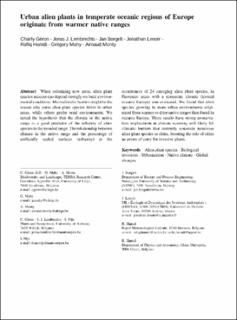| dc.contributor.author | Géron, Charly | |
| dc.contributor.author | Lembrechts, Jonas J. | |
| dc.contributor.author | Borgelt, Jan | |
| dc.contributor.author | Lenoir, Jonathan | |
| dc.contributor.author | Hamdi, Rafiq | |
| dc.contributor.author | Mahy, Grégory | |
| dc.contributor.author | Nijs, Ivan | |
| dc.contributor.author | Monty, Arnaud | |
| dc.date.accessioned | 2021-11-04T12:17:21Z | |
| dc.date.available | 2021-11-04T12:17:21Z | |
| dc.date.created | 2021-08-04T14:43:21Z | |
| dc.date.issued | 2021 | |
| dc.identifier.citation | Biological Invasions. 2021, 23 (6), 1765-1779. | en_US |
| dc.identifier.issn | 1387-3547 | |
| dc.identifier.uri | https://hdl.handle.net/11250/2827879 | |
| dc.description.abstract | When colonizing new areas, alien plant species success can depend strongly on local environmental conditions. Microclimatic barriers might be the reason why some alien plant species thrive in urban areas, while others prefer rural environments. We tested the hypothesis that the climate in the native range is a good predictor of the urbanity of alien species in the invaded range. The relationship between climate in the native range and the percentage of artificially sealed surfaces (urbanity) at the occurrences of 24 emerging alien plant species, in European areas with a temperate climate (termed oceanic Europe) was evaluated. We found that alien species growing in more urban environments originated from warmer or drier native ranges than found in oceanic Europe. These results have strong conservation implications as climate-warming will likely lift climatic barriers that currently constrain numerous alien plant species to cities, boosting the role of cities as points of entry for invasive plants. | en_US |
| dc.language.iso | eng | en_US |
| dc.publisher | Springer | en_US |
| dc.title | Urban alien plants in temperate oceanic regions of Europe originate from warmer native ranges | en_US |
| dc.type | Peer reviewed | en_US |
| dc.type | Journal article | en_US |
| dc.description.version | acceptedVersion | en_US |
| dc.rights.holder | This is the authors' accepted manuscript to an article published by Springer. Locked until 18.2.2022 due to copyright restrictions. | en_US |
| dc.source.pagenumber | 1765-1779 | en_US |
| dc.source.volume | 23 | en_US |
| dc.source.journal | Biological Invasions | en_US |
| dc.source.issue | 6 | en_US |
| dc.identifier.doi | 10.1007/s10530-021-02469-9 | |
| dc.identifier.cristin | 1923907 | |
| cristin.ispublished | true | |
| cristin.fulltext | postprint | |
| cristin.qualitycode | 1 | |
